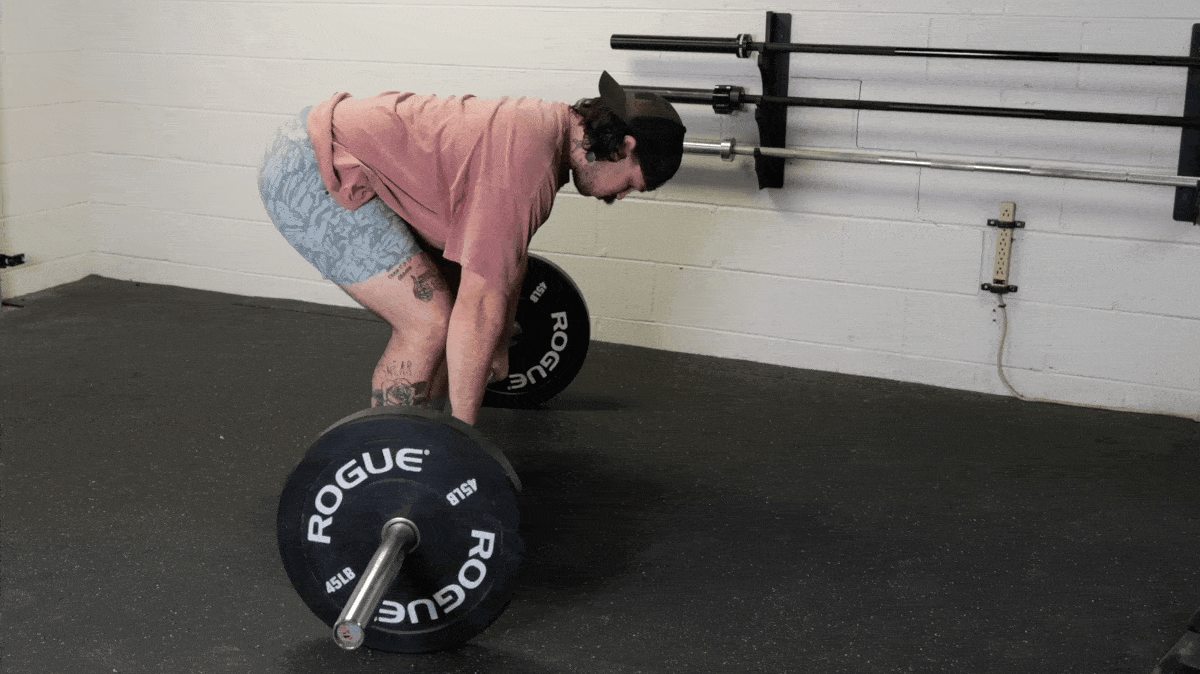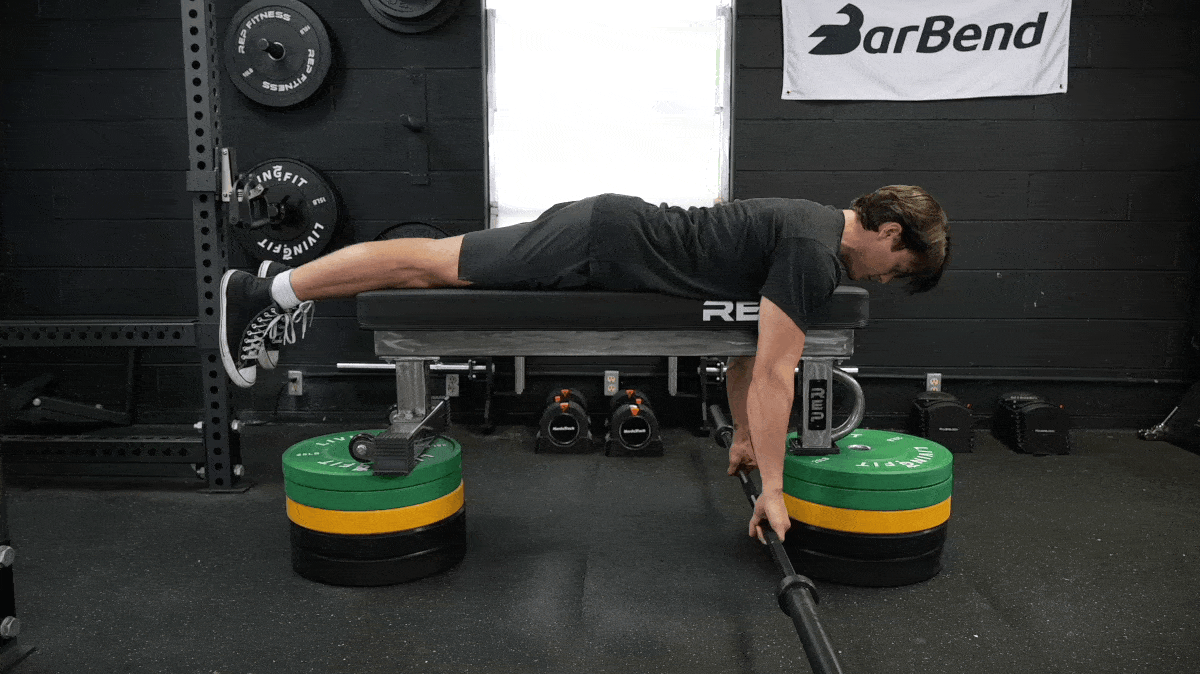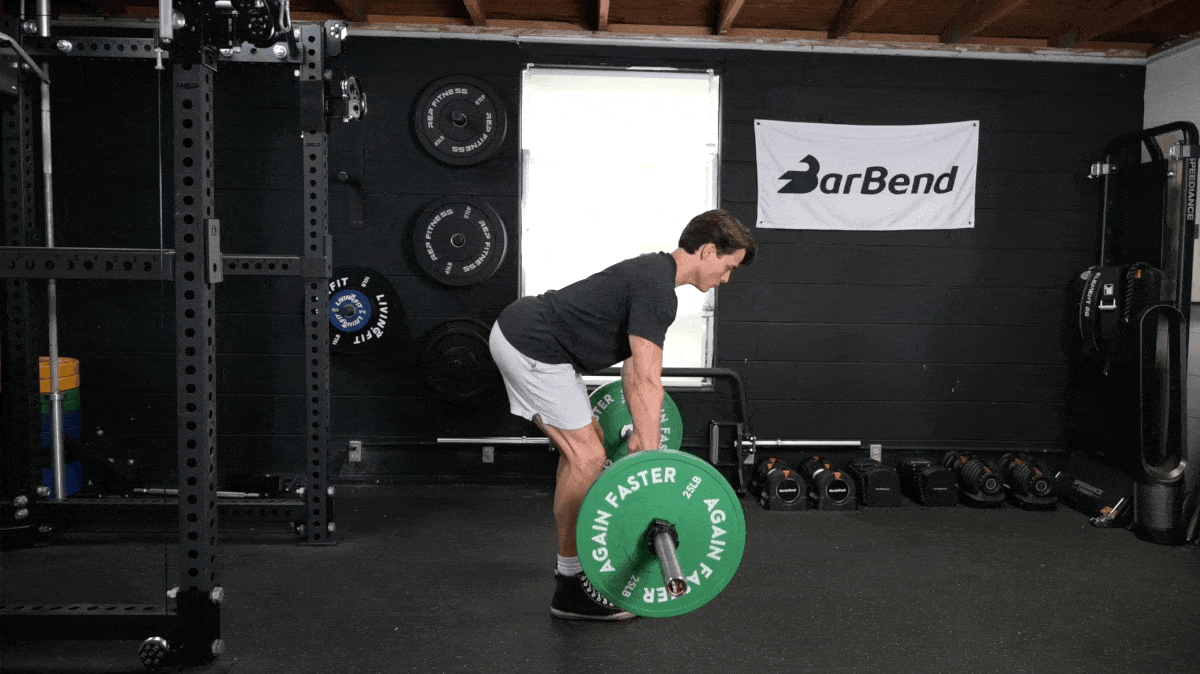If you’ve never heard of the Pendlay row — which is a close variation to the bent-over barbell row — you may well be skimping on your back gains. Innovated by USA Weightlifting coach Glenn Pendlay, this row variation specifically targets back strength and muscular development for pulling movements, such as snatches, cleans, and deadlifts. This comprehensive guide will explore how the Pendlay row can be a useful exercise for you as a weightlifter or someone looking to beef up their back.
Editor’s Note: The content on BarBend is meant to be informative in nature, but it shouldn’t take the place of advice and/or supervision from a medical professional. The opinions and articles on this site are not intended for use as diagnosis, prevention, and/or treatment of health problems. Speak with your physician if you have any concerns.
How to Do the Pendlay Row

- Set Up: With the barbell on the floor, set up with a slightly wider than shoulder-width grip. Set your hips as you would for a deadlift, but a little higher.
- Brace and Pull: Brace your core and use your lats to explosively pull the barbell to the base of your chest. Make sure not to elevate your shoulders or allow your hips to come forward.
Coach’s Tip: Drive your feet into the floor and think about pulling the barbell to your hips.
Pendlay Row Variations
Not all Pendlay rows look the same. Just like you can get creative with deadlift variations, there are multiple types of Pendlay rows to add to your tool box.
Pendlay Row From Blocks
[Read More: How to Do the Reverse-Grip Bent-Over Row for Bigger Lats and Beefier Biceps]
- Set a loaded barbell on top of a pair of lifting blocks or risers such that it is a few inches higher than usual.
- Get into a hinged position and grab ahold of the bar with a double overhand grip.
- Explosively row the bar off the blocks and into your abdomen.
By raising the bar off the ground, you’re reducing the range of motion that the barbell needs to travel. If you don’t have the greatest mobility, this adjustment can help you achieve a more comfortable starting position.
Deficit Pendlay Row
[Read More: Rack Pulls vs Rows – Which Is Best for Strength?]
- Stand on top of a pair of change plates or a low riser.
- Hinge over and grab the bar.
- Brace your core and explosively row it up into your abdomen.
Performing the barbell Pendlay row from a deficit grants you all the back-building benefits, but with the bonus of an increased range of motion. For lifters who want to increase muscle growth, the lengthened range of motion allows you to stretch the muscle and increase the muscles’ time under tension.
Pendlay Row Alternatives
Looking for more ways to improve back strength and muscle hypertrophy? Check out these alternatives to Pendlay rows that can make your back gains really pop.
Seal Row

[Read More: Barbell Row Alternatives]
- If you don’t have a seal row bench, you’ll need to stack a weight bench on top of several bumper plates or two plyo boxes.
- Lie on the bench on your stomach with the bar perpendicular underneath.
- Grab the bar and row it up into the bench.
The seal row mimics the posture you’d use for a Pendlay row, but completely removes any stress on your lower back. Use this one if you like how the Pendlay row feels but can’t load your spine.
Bent-Over Row

[Read More: Barbell Row Vs. Dumbbell Row — Which Is Best for Strength, Hypertrophy, and Fitness?]
- Stand upright while holding a barbell with a narrow grip, then hinge at the hips and tip over until your torso is roughly parallel to the ground.
- Brace your core and row the bar up into your belly, then lower it back down under control.
This rowing variation is nearly identical to the Pendlay row except that you don’t rest the weight on the ground after each rep. Because you’re supporting the weight fully for the duration of your set, your lower back is even more taxed in this variation.
Who Should Do the Pendlay Row
You don’t have to be an elite athlete to reap elite benefits from the Pendlay row. And just because it’s accessible to intermediate lifters doesn’t mean seasoned lifters won’t get a lot out of it.
Strength and Power Athletes
Strength and power athletes can benefit immensely from including the Pendaly row into their strength and hypertrophy training:
- Powerlifters and Strongmen/Strongwomen: This assistance exercise allows for more specific training of your hips and back, both of which play a crucial role in deadlifting. Additionally, lifters can improve your lumbar spine’s stabilization in a hinged position, helping develop a healthier, stronger deadlift.
- Olympic Weightlifters: This exercise’s main goal in weightlifting training is to develop and increase lat and lower back strength and muscle, similar to the pulls in both weightlifting movements. Increasing the hips and back isolation allows lifters to apply additional stress to promote muscular hypertrophy under a full range of motion.
General Population
For general population lifters — meaning anyone who isn’t planning to compete — adding in back exercises is excellent for improving your posture, gym performance, and minimizing injury risk.
[Read More: Glenn Pendlay Explains the Pendlay Row History]
However, the Pendlay row is more advanced for most beginners, as it requires flexibility and proper hip hinge mechanics (which doesn’t always come naturally to people). If you’re new to lifting, start with seated row variations, such as the seated cable row or chest-supported rows.
Pendlay Row Sets and Reps
Even though it’s a solid compound movement, the Pendlay row is ultimately an accessory exercise. As such, you’re not going to aim to load it to the max. You can still use it to build up your strength, though. Since you’ll generate maximum force on each rep — pulling from a dead stop every time will do that — it’s also a great option when you want to build muscle and boost muscular endurance.
- For Strength: Do three to five sets of four to eight reps with heavy (but submaximal) weight.
- For Muscle Mass: Perform three to four sets of eight to 15 reps with moderately heavy weight.
- For Endurance: Perform three to four sets of 15 to 20 reps with challenging but light weight.
Benefits of the Pendlay Row
The Pendlay row might “just” be an accessory move, but there’s nothing little about the gains it can help you achieve.
Bigger, Stronger Back
When looking to build a strong back for either aesthetic purposes or to carry over to other lifts, it’s important to train with volume, load, and focused contractions. The Pendlay row allows you to load the bar with relatively heavy weight compared to other back-specific movements, yet it still forces full ranges of motion (if done correctly) to maximize back hypertrophy.
Better Deadlifts and Squats
The ability to contract and brace your back is essential for maintaining proper posture during moves like the deadlift, back and front squat, and the bench press. As you lift more weights in those movements, the demand on your back will be greater.

[Read More: Pendlay Row Vs. Barbell Row — Which Is Best for Strength and Hypertrophy?]
To ensure your ability to brace your back stays up to speed with the rest of the lift, you should add Pendlay rows to your routine. Because each rep is done from a dead stop on the floor, you’re forced to brace each time you lift the bar. That’s great practice for even bigger lifts.
More Pulling Prowess
For strength athletes, performing the Pendlay row can be a top priority. This is especially true if you lack positional strength in your hamstrings and back. The Pendlay row does a great job of increasing static and concentric strength, and both are needed during the snatch, clean & jerk, and breaking through sticking points in those specific lifts. Pendlay rows can aid in the squat and deadlift for powerlifters, as they increase lower back strength and upper back strength.
Muscles Worked by the Pendlay Row
The Pendlay row targets large muscle groups across your body. That’s bound to assist you in more complex movements like deadlifts, squats, and weightlifting exercises.
Latissimus Dorsi
Your lats are a large slab of thin, triangular muscle that spans pretty much the entire length of your back. They are involved in scapular depression as well as the flexion (or pulling) of your arms. Anytime you pull something to you, you’re engaging your lats.
Hamstrings
No, your legs won’t be moving — but that doesn’t mean they won’t be working. Your hamstrings work isometrically to support you as you assume the bent over position in the Pendlay row. They’ll get a small break when the bar touches the ground between reps, but your hamstrings will still get hammered when you’re going heavy or to high volume.
Spinal Erectors
Your spinal erectors work to stabilize your spine during this bent-over row variation, as you’re hinged over for the entire movement. Strengthening your back with isometrics like this can directly correlate to a more powerful deadlift setup and pulling position in the deadlift or any movement in which a load is lifted from the floor.
Common Pendlay Row Mistakes
The Pendlay row is meant to be challenging — you’ll have to maintain a strong hip hinge throughout the lift. Plus, you won’t have the benefit of momentum to help you kick off each rep. Whenever an exercise is designed to make up the ante of a classic (in this case, the bent-over row), you’re bound to run into some common mistakes.
Back Angle
There are definitely times when cheating your form can boost your gains — but an unsupported hinge generally isn’t that time. Just as you might be tempted to partially stand straight up during the Pendlay row, you might try to yank with your arms. You may also try to tug up with your back by raising your shoulders relative to your hips. This will likely result in your back jerking upright from momentum before sneaking back into its ideal position. You also won’t be maintaining the integrity of your hip hinge, which is an important part of keeping the Pendlay row as effective as possible.
[Read More: Do Different Row Grips Matter]
To avoid this, lock down your Pendlay row form with light weight before advancing your load. Set up for each rep by packing your shoulders back and down. Then, squeeze your shoulder blades together to initiate the pull. Focus on keeping your hips pushed back, too.
Flaring Your Elbows
It’s okay if your elbows don’t stay tucked completely by your sides throughout this lift. This is especially the case for lifters with longer arms, who may need to angle their elbows out a bit wider to accommodate the pull. But completely “chicken-winging” your elbows out to the sides can put your shoulders in a compromising position. It’ll also put more emphasis on your arms and shoulders than your lats.
If you feel yourself yanking the bar and splaying your elbows out to the sides, lighten the load until the problem diminishes. You can also try cueing yourself to put your elbows in your pockets or to pull the bar to your hips. Experiment a bit to find a cue that works for you.
Going Too Heavy
If you feel like you have to dramatically raise your back angle or yank the weight up, you’ve probably slapped too many plates on the bar. It’s not a bad thing that the Pendlay row is a humbling experience. By concentrating on moving less weight with perfect form, you’ll be able to build up to more plates, more quickly. Instead of focusing on increasing your load, try to stick to the same load and increase the number of quality sets and reps you can perform. When you hit your target number, then go back and gradually add more weight.
FAQs
Thinking about bedazzling your back training with Pendlay rows but have some last-minute questions before you do? Get your answers here.
The main differences between the two are the set-up position and specificity to pulling movements. In the Pendlay row, you’ll set up with your back roughly parallel to the floor. This makes it much more difficult to assume a proper start position than with other types of rows.
The Pendlay row also has great application to movements like deadlifts and cleans. That’s because the barbell starts from a static position on the floor. You’ll pull it upward without allowing your hips to move up or down. This reinforces a strong setup and start position for those more advanced movements.
While the Pendlay row was originally meant to be used with a barbell specific to Olympic weightlifting and strength, it has evolved over the years to become a movement in and of itself. For that reason, you can certainly use dumbbells or kettlebells. However, some circles may insist that the Pendlay row is exclusively with a barbell, and anything else is just a bent-over row.
If you have issues keeping your hips still, focus on locking your knees and hips in a bent position. Push through the floor prior to lifting and brace your core. From there, you may also need to simply use less weight.
Featured Image: BigBlueStudio / Shutterstock